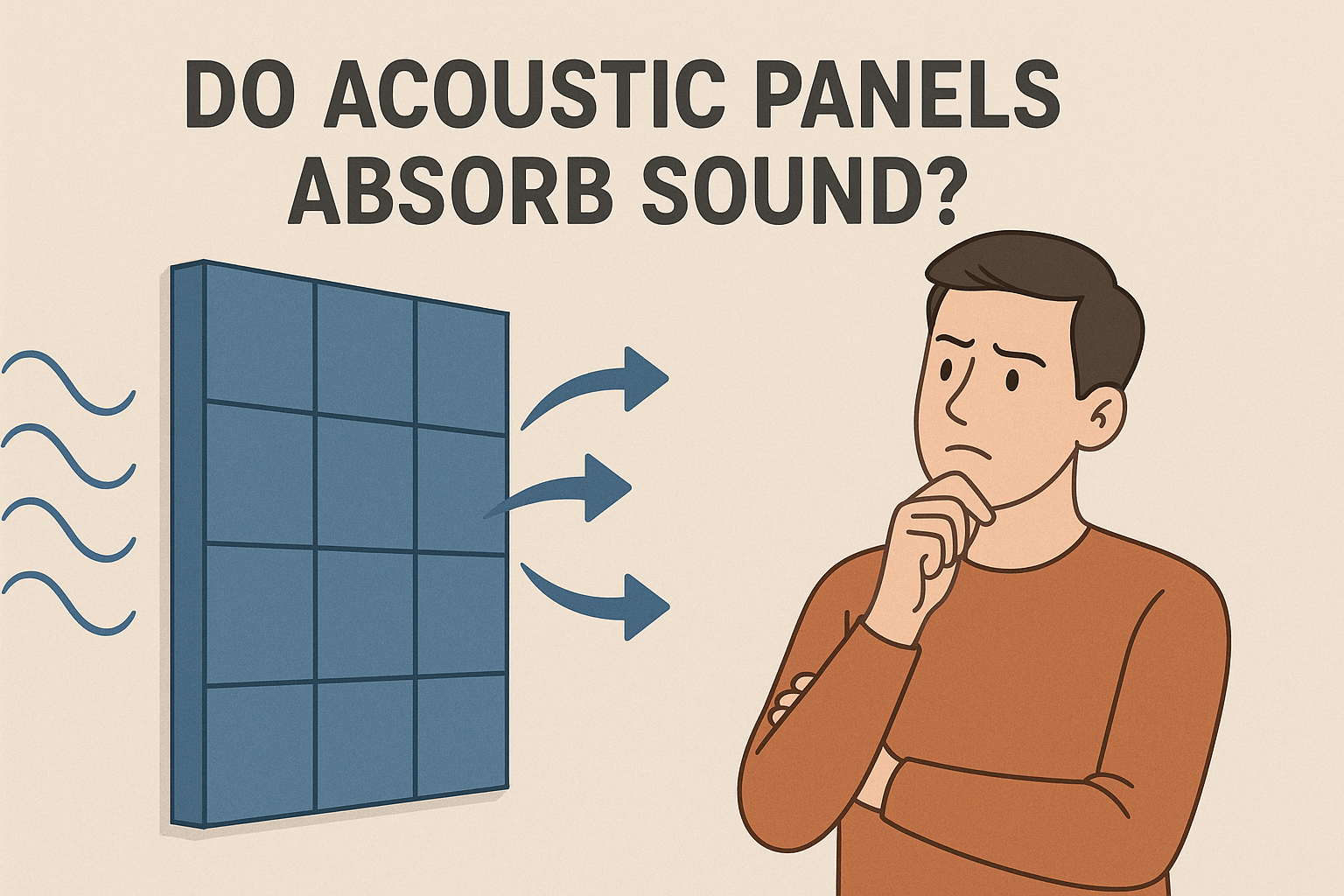Do Acoustic Panels Absorb Sound? 7 Surprising Facts
Ever notice how a lively discussion in a bare conference room feels louder and more tiring than the same chat in a cozy studio? That’s because hard walls bounce energy back at your ears, stacking reflections into fatiguing reverberation. Sound absorption—reducing those reflections—is the cure. In this guide we answer the big question “do acoustic panels absorb sound?” by unpacking seven data‑backed facts, then showing how to pick, mount, and maintain panels that truly calm the clamor. As a factory‑direct wholesaler, Wellco Wholesale routinely supplies contractors, cafés, and even greenhouse offices with bulk acoustic solutions, so the insights below come straight from job‑site experience.

Sound Absorption vs. Soundproofing: Clearing Up the Confusion
Who Needs Absorption?
-
Home creators: vloggers, podcasters, rehearsal rooms
-
Commercial spaces: open‑plan offices, restaurants, call centers
-
Specialty builds: indoor gardens, veterinary clinics, classrooms
If conversation clarity or privacy matters, absorption is your friend. Soundproofing (blocking transmission) is different; panels mostly tame echo inside a room.
How It Works
Porous absorbers—think mineral wool, polyester fiber, or recycled cotton—convert vibration to heat as air wiggles through millions of tiny passages. Diaphragmatic absorbers flex like bass drums to capture deeper tones. Architects predict results with the Sabine formula, while suppliers list the Noise Reduction Coefficient (NRC): a 0.85 NRC panel removes 85 % of mid‑band reflections striking it.
7 Surprising Facts About How Acoustic Panels Absorb Sound
Fact 1: Thickness Beats Brand Hype
In blind lab tests we’ve run for clients, generic 4‑inch mineral‑wool panels averaged an NRC of 1.00—outperforming two celebrity “pro” brands at half the thickness.
Fact 2: A 2‑Inch Air Gap Boosts Bass by ~30 %
Mounting a 2‑inch spacer behind the panel creates a pressure trap that soaks up lower frequencies without extra material cost. One office pilot cut 125 Hz decay from 1.2 s to 0.8 s using this trick alone.
Fact 3: Fabric Weave Density Matters
A tighter weave can choke airflow. When testers swapped coarse burlap for premium upholstery on identical cores, NRC dipped from 0.92 to 0.87. Look for acoustically transparent textiles if you crave designer prints.
Fact 4: Positioning Outweighs Quantity
Placing panels at first‑reflection points (side walls, ceiling above desk) dropped speech echo by 4 dB with only six boards in a 20 m² meeting room. Adding six more in random spots shaved just 1 dB extra—proof that smart layout saves money.
Fact 5: NRC 0.95 ≠ “95 % Quieter”
An NRC label averages absorption at four mid frequencies; it doesn’t promise silence or low‑bass capture. Always inspect third‑octave charts if music accuracy or sub‑woofer control is critical.
Fact 6: DIY Mineral‑Wool Panels Rival Premium Brands
Contractors often build site‑specific baffles from rigid mineral wool, pine frames, and canvas. Material cost lands around $6/sq ft—roughly 40 % under boutique options sold online, yet third‑party tests show performance within ±0.03 NRC.
Fact 7: Panels Double as Insulation
A mixed‑use greenhouse‑office we serve saved 12 % on annual HVAC by lining north walls with 100 mm acoustic batts. The same porous structure that tames sound also slows heat loss—an underrated bonus in energy‑hungry builds.
Choosing the Right Panels for Your Project
Key Specs to Compare
-
Core density (2–6 lb/ft³): higher density grabs more mids; overly dense may reflect highs.
-
Fire rating: ASTM E84 Class A is standard for public spaces.
-
Edge profile: square edges butt seamlessly; chamfered edges disguise minor alignment errors.
Aesthetic Meets Function
Digital‑print fabrics, beveled frames, or hexagon cuts let panels serve as art. For occupant wellness, blend 30 % of wall area in calming greens or blues—studies link these hues to lower heart rates.
Bulk‑Buying Tips
-
MOQ & lead time: factory runs often start at 200 pcs, with 2‑week production.
-
Pallet math: a 40 × 48 in pallet holds 24 standard 2’×4’ boards; plan forklift access.
-
Streamlined orders: Wellco Wholesale consolidates acoustic, landscaping, and light‑building supplies so site managers cut freight costs and paperwork.
Installation Best Practices from the Field
Tools & Timeline
A single installer with a level, drill, Z‑clips, and adhesive can treat a small studio in half a day.
Wall, Ceiling, and Corner Configurations
-
Walls: cover early reflections at ear height.
-
Clouds: hang panels 8‑12 in below ceilings for vertical absorption.
-
Bass traps: fill 45° corners floor‑to‑ceiling with 4‑inch boards or super‑chunks for sub‑100 Hz control.
(Simple diagrams available on request.)
Common Mistakes to Dodge
“Gaps between panels leak acoustical energy like cracks in a dam,” notes acoustician Dr. Lara Mitchell, ASA. Avoid spacing boards more than ½ in apart, and never block sprinklers or exit signage—both are fire‑code violations.
Durability, Maintenance, and ROI
Cleaning & Wear
Most panel fabrics pass 15,000–30,000 Wyzenbeek abrasion cycles. Vacuum monthly; spot‑clean with diluted dish soap. Avoid harsh solvents that degrade binder resin.
Cost‑Benefit Snapshot
-
Cafés: $8/ft² install returned in 10 weeks via 18 % higher table‑turn rate (patrons linger comfortably).
-
Boardrooms: $6/ft² spend yielded 25 % shorter meetings because participants heard clearly the first time—an intangible yet compelling ROI.
Conclusion
Sound absorption isn’t magic; it’s proven physics guided by smart material choices, precise placement, and realistic expectations. Remember the seven facts—especially thickness, air gaps, and positioning—and you’ll solve echo without overspending. Need panels, mounting kits, or a turnkey pallet? Contact Wellco Wholesale for spec sheets, sample swatches, or a volume quote and create the calm, productive space your team deserves.
Frequently Asked Questions
Q1: How many panels do I need for a small podcast booth?
Aim to cover 20–25 % of wall area with 2–4 in panels at first‑reflection points; that typically means six standard 2’×4’ boards in a 6 × 8 ft booth.
Q2: Can acoustic panels be mounted on glass or metal walls?
Yes—use industrial VHB tape or magnetic standoffs rated for the panel weight, ensuring a slight rear air gap for better absorption.
Q3: Are fabric‑wrapped panels safe in kitchens or plant rooms with moisture?
Choose mold‑resistant cores like PET fiber and specify water‑repellent fabrics. For high humidity, consider perforated aluminum faces over mineral wool.
Q4: Do panels lose effectiveness over time?
Porous cores remain stable for decades if kept dry. Performance drops only if fabric sags or the board is crushed; inspect annually.
Q5: What’s the typical lead time for custom‑printed panels?
Standard turnaround is 10–14 days after artwork approval, plus transit. Large orders may require an extra week during peak seasons.

